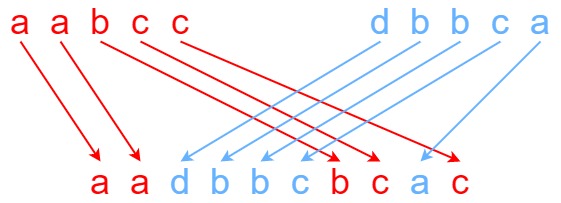0097 - Interleaving String (Medium)
Problem Link
https://leetcode.com/problems/interleaving-string/
Problem Statement
Given strings s1, s2, and s3, find whether s3 is formed by an interleaving of s1 and s2.
An interleaving of two strings s and t is a configuration where s and t are divided into n and m substrings respectively, such that:
s = s1 + s2 + ... + snt = t1 + t2 + ... + tm|n - m| <= 1- The interleaving is
s1 + t1 + s2 + t2 + s3 + t3 + ...ort1 + s1 + t2 + s2 + t3 + s3 + ...
Note: a + b is the concatenation of strings a and b.
Example 1:

Input: s1 = "aabcc", s2 = "dbbca", s3 = "aadbbcbcac"
Output: true
Explanation: One way to obtain s3 is:
Split s1 into s1 = "aa" + "bc" + "c", and s2 into s2 = "dbbc" + "a".
Interleaving the two splits, we get "aa" + "dbbc" + "bc" + "a" + "c" = "aadbbcbcac".
Since s3 can be obtained by interleaving s1 and s2, we return true.
Example 2:
Input: s1 = "aabcc", s2 = "dbbca", s3 = "aadbbbaccc"
Output: false
Explanation: Notice how it is impossible to interleave s2 with any other string to obtain s3.
Example 3:
Input: s1 = "", s2 = "", s3 = ""
Output: true
Constraints:
0 <= s1.length, s2.length <= 1000 <= s3.length <= 200s1,s2, ands3consist of lowercase English letters.
Follow up: Could you solve it using only O(s2.length) additional memory space?
Approach 1: 2D Dynamic Programming
If we try to break down our problem into a sub problem we get that we are trying to find whether the characters in up to and the characters in up to can interleave to create a string in up to .
So to construct our 2D grid we would need a grid of size wide and tall of all false/falsy values. This allows us to account for the empty string prefix of both and . We would then initialize the position as a true/truthy value, as we know we can create the empty using the empty and strings.
For values in our grid, it maps out values to position is and values to position in . This means that for each value in our grid it tells us whether we can create using the characters from and .
So then for each i,j we know if it isn't the first row or column (our empty string values), and that if the character from the previous iteration of matches the previous iteration character of
Time Complexity: where is the length of and is the length of . We are iterating over our dp array of size .
Space Complexity: . Our dp array will be of size .
- Python
class Solution:
def isInterleave(self, s1: str, s2: str, s3: str) -> bool:
# return early if s1 and s2 combined aren't same size as s3.
if len(s1) + len(s2) != len(s3):
return False
# create our 2d grid, we need an extra row/col to account for
# the empty string case when comparing either empty s1/s2 values.
dp = [[0 for _ in range(len(s2) + 1)] for _ in range(len(s1) + 1)]
# initialize first value to be truthy, as we know we can create
# s3="" using s1="" and s2="". This is the initial base case of
# interleaving 2 empty string to equal an empty string.
dp[0][0] = 1
# loop through the 2d dp array. Remembering the first row/col
# handles the empty string sub-problems.
for i in range(len(s1) + 1):
for j in range(len(s2) + 1):
# check 3 things for each position in s1, s2.
#1. i/j > 0: We can't check positions of less than
# the empty "" string value. i/j == 0, that handles
# empty strings, and their is no way to be < empty.
#2. Check string value at s1[i-1] == s3[i+j-1]. This
# is checking if the letters at the proper position are
# equal. Note we subtract 1, since we added a extra
# row/col to the start of each row/col in dp table.
#3. And if prevs 2 are truthy, We check that it held the
# same for the previous i value.
if i > 0 and s1[i-1] == s3[i+j-1] and dp[i-1][j]:
# if so, we can call this true/truthy
dp[i][j] = 1
if j > 0 and s2[j-1] == s3[i+j-1] and dp[i][j-1]:
dp[i][j] = 1
# the full string would be represented by the length os s1,s2
# in our dp table.
return dp[len(s1)][len(s2)]